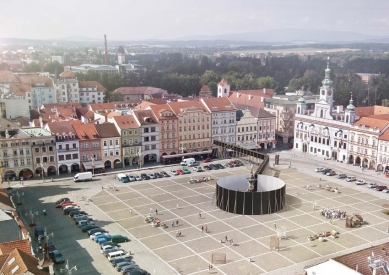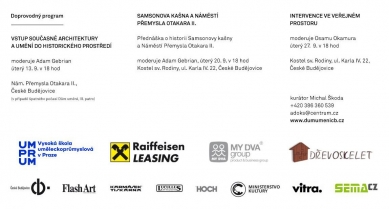
Jan Šépka - Perception - Invitation to a Lecture and Opening Reception
Gallery of Contemporary Art and Architecture - House of Art of the City of České Budějovice
Source
Dům Umění města České Budějovice
Dům Umění města České Budějovice
Publisher
Tisková zpráva
07.09.2016 00:05
Tisková zpráva
07.09.2016 00:05
Jan Šépka
Šépka architekti
Lecture by the author: September 7, 2016, at 5:00 PM in the student church of the Holy Family, Karla IV. 22, České Budějovice
Opening: September 7 at 7:00 PM in Přemysl Otakar II Square.
Exhibition: September 8 – October 2, 2016
Collaboration: Ing. arch. Jan Bárta
Curator: Michal Škoda
The next exhibition of this year's season is a project by architect Jan Šépka, which, as part of a block of architectural exhibitions, aims not only to offer an opportunity to experience and perceive the gallery environment and the square space a bit differently but primarily to raise a series of questions and open topics concerning not only art and architecture as such but especially the perception of the city - the place within everyday life.
This exhibition is not solely based on its own artistic and architectural intervention but will also be complemented / every Tuesday at 6:00 PM / by the participation of guests from among experts, artists, architects, and politicians - with a block of lectures and discussion programs for the public relating to the history and current use of the square, as well as the relationship between contemporary art and architecture.
Perception
The project is a reflection on what we consider an important component and a dominant feature of public space, and how we perceive some hidden spaces that provide us with social and cultural activities.
The Baroque Samson Fountain located in Přemysl Otakar II Square in České Budějovice is one of the largest of its kind in the country and represents a significant monument and symbol of the city. Its artistic quality is undeniable, and currently, none of us can imagine the square without this dominant feature. The question, however, may be whether we perceive such dominants today only inadvertently. We pass by them every day and, due to their historically and spatially confirmed value, we no longer think about the essence of this monument or its relationship to the generous square space.
In contrast, the spaces on the first floor of the House of Art, which have offered very high-quality artistic experiences in recent years, are obscured from our view. A visitor unfamiliar with the situation finds it difficult to locate the gallery. It is evident that a certain form of concealment of the gallery space may be an advantage; however, the experience of the exhibition and any discussion about art and culture fades from our everyday repertoire.
The project aims to highlight how we perceive, or rather do not perceive, the dominants and hidden places that are not far from each other, located in the center of events, and offer cultural activities. The purpose should be to disrupt our stereotypical perception of such values and to encourage reflection and discussion on these topics.
The Samson Fountain will find itself in a circular space for about a month, which will both separate it from the square itself and simultaneously create a calm background and intimacy that this dominant feature has never had. The fountain will thus exist like a jewel in a gallery. The circular space will be directly connected by a pathway with stairs to the first-floor space of the House of Art, where a circle will reappear, but in different contexts. The visitor in the gallery space will only be able to move along the defined circular path and will actually not reach the open spaces of the gallery. They will perceive the space only through the ceiling, which will not be installed in the inner promenade. The intentional alienation of the fountain and the emphasis on the entrance to the House of Art through the window is the overall meaning of the project. Thus, things that seemingly have no relation find themselves in an interesting confrontation.
Jan Šépka was born in 1969 in Prague. He graduated from the Faculty of Architecture at the Czech Technical University and the Academy of Fine Arts School of Architecture in Prague. In 1994, he co-initiated the association Nová česká práce with Michal Kuzemenský. In 1998, he co-founded and was a partner in the office HŠH architekti, which operated until 2009. He then established his own office Šépka architekti. From 2004-14, he served as a lecturer at the Faculty of Architecture at the Czech Technical University in Prague. From 2014-16, he was the head of the Project and Competition Office at IPR in Prague, and since September 2014, he has led studio A1 at UMPRUM, where he was appointed Associate Professor for the field of Architecture last year. In 2006, he was the editor of the yearbook Česká architektura and in 2015 published the book “How a City is Made”. Many projects he was involved in have received awards both in the Czech Republic and abroad. Among the most renowned are the modifications of Horní náměstí in Olomouc, the modifications of Jiřské náměstí at Prague Castle, the Archdiocesan Museum in Olomouc, a villa in Beroun, villa Hermína, modifications of the castle hill in Litomyšl, the design of the National Library in Prague, and Room in the Landscape in Modrava.
More information >
Opening: September 7 at 7:00 PM in Přemysl Otakar II Square.
Exhibition: September 8 – October 2, 2016
Collaboration: Ing. arch. Jan Bárta
Curator: Michal Škoda
The next exhibition of this year's season is a project by architect Jan Šépka, which, as part of a block of architectural exhibitions, aims not only to offer an opportunity to experience and perceive the gallery environment and the square space a bit differently but primarily to raise a series of questions and open topics concerning not only art and architecture as such but especially the perception of the city - the place within everyday life.
This exhibition is not solely based on its own artistic and architectural intervention but will also be complemented / every Tuesday at 6:00 PM / by the participation of guests from among experts, artists, architects, and politicians - with a block of lectures and discussion programs for the public relating to the history and current use of the square, as well as the relationship between contemporary art and architecture.
Perception
The project is a reflection on what we consider an important component and a dominant feature of public space, and how we perceive some hidden spaces that provide us with social and cultural activities.
The Baroque Samson Fountain located in Přemysl Otakar II Square in České Budějovice is one of the largest of its kind in the country and represents a significant monument and symbol of the city. Its artistic quality is undeniable, and currently, none of us can imagine the square without this dominant feature. The question, however, may be whether we perceive such dominants today only inadvertently. We pass by them every day and, due to their historically and spatially confirmed value, we no longer think about the essence of this monument or its relationship to the generous square space.
In contrast, the spaces on the first floor of the House of Art, which have offered very high-quality artistic experiences in recent years, are obscured from our view. A visitor unfamiliar with the situation finds it difficult to locate the gallery. It is evident that a certain form of concealment of the gallery space may be an advantage; however, the experience of the exhibition and any discussion about art and culture fades from our everyday repertoire.
The project aims to highlight how we perceive, or rather do not perceive, the dominants and hidden places that are not far from each other, located in the center of events, and offer cultural activities. The purpose should be to disrupt our stereotypical perception of such values and to encourage reflection and discussion on these topics.
The Samson Fountain will find itself in a circular space for about a month, which will both separate it from the square itself and simultaneously create a calm background and intimacy that this dominant feature has never had. The fountain will thus exist like a jewel in a gallery. The circular space will be directly connected by a pathway with stairs to the first-floor space of the House of Art, where a circle will reappear, but in different contexts. The visitor in the gallery space will only be able to move along the defined circular path and will actually not reach the open spaces of the gallery. They will perceive the space only through the ceiling, which will not be installed in the inner promenade. The intentional alienation of the fountain and the emphasis on the entrance to the House of Art through the window is the overall meaning of the project. Thus, things that seemingly have no relation find themselves in an interesting confrontation.
Jan Šépka
Jan Šépka was born in 1969 in Prague. He graduated from the Faculty of Architecture at the Czech Technical University and the Academy of Fine Arts School of Architecture in Prague. In 1994, he co-initiated the association Nová česká práce with Michal Kuzemenský. In 1998, he co-founded and was a partner in the office HŠH architekti, which operated until 2009. He then established his own office Šépka architekti. From 2004-14, he served as a lecturer at the Faculty of Architecture at the Czech Technical University in Prague. From 2014-16, he was the head of the Project and Competition Office at IPR in Prague, and since September 2014, he has led studio A1 at UMPRUM, where he was appointed Associate Professor for the field of Architecture last year. In 2006, he was the editor of the yearbook Česká architektura and in 2015 published the book “How a City is Made”. Many projects he was involved in have received awards both in the Czech Republic and abroad. Among the most renowned are the modifications of Horní náměstí in Olomouc, the modifications of Jiřské náměstí at Prague Castle, the Archdiocesan Museum in Olomouc, a villa in Beroun, villa Hermína, modifications of the castle hill in Litomyšl, the design of the National Library in Prague, and Room in the Landscape in Modrava.
More information >
The English translation is powered by AI tool. Switch to Czech to view the original text source.




0 comments
add comment
Related articles
0
19.09.2025 | Jan Šépka: Fountains, Hills, and Clouds - Exhibition in Kadaň
0
23.11.2024 | Center of the Petřiny housing estate in the Skleňák gallery
0
29.10.2019 | Jan Šépka: Inspiration - Invitation to the Publication Presentation
0
24.03.2019 | Jan Šépka: Variants
0
27.09.2016 | Jan Šépka - Perception - final debate and night tour
0
11.09.2016 | Jan Šépka - Perception - accompanying program
0
07.09.2016 | The Samson Fountain in České Budějovice is covered by wooden walls
21
19.05.2016 | The project Perception by Jan Šépka will cover the fountain in České Budějovice for a month










